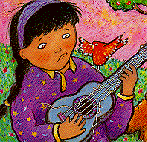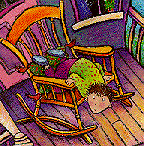


|
Two Too Many.
Jo Ellen Bogart. Illustrated by Yvonne Cathcart.
Richmond Hill, ON: Scholastic Canada, 1996. 24pp, paper, $5.99.
ISBN: 0-590-24906-1.
Grades K - 2 / Ages 5 - 8.
Review by Leslie Millar.
**/4
|
excerpt:
Reginald had two too many rockers on his chair.
Madeleine had two too many saddles on her mare.
Eleanora's elephant had two too many knees.
Susan's Mississippi had two too many ``P"'s.
 Jo Ellen Bogart has written a counting book of sorts in Two Too Many. She makes her home in Guelph, Ontario and has published several children's books, among them Gifts, Mama's Bed, Sarah Saw a Blue Macaw, and Malcolm's Runaway Soap.
Jo Ellen Bogart has written a counting book of sorts in Two Too Many. She makes her home in Guelph, Ontario and has published several children's books, among them Gifts, Mama's Bed, Sarah Saw a Blue Macaw, and Malcolm's Runaway Soap.
Two Too Many is presented as a pre-school story. There is one line of text for each full page of illustration, but the concept of ``two too many" is quite abstract, making it unsuitable for younger audiences. It is not really a counting book in the true sense of the genre. Counting books typically offer a logical counting progression that readers can work out, anticipate, and succeed at.
For example, the lovable bug in Eric Carle's The Very Hungry Caterpillar eats his way through one apple on Monday, two pears on Tuesday, three grapes on Wednesday, and so on. In Two Too Many there are a different number of items to count on each page. Two extra bedposts make six bedposts in total, two extra saddles make three, two extra antlers make four. . . . There is no pattern to work with. And counting ``two" of anything -- as in ``two too many" -- does not qualify as a counting book at ages five to eight.
Many of the ``two too many" items, such as bedposts, reels, and the balsa-wood biplane, may be unfamiliar to children. Some illustrations deal with the idea that even one of some things would be too much: the line ``Marvin's mama gave him two too many brussel sprouts" is illustrated by two sprouts on an otherwise empty plate with an obviously unhappy Marvin looking on.

The joke is that Marvin hates brussel sprouts and that even one is too many for him. But this abstract concept elicited blank stares from the test group of five-year-olds I read the story to, as did the other illustration dealing with the same point.
At ages five to eight, children are learning the rudiments of counting and basic math. Confusing and illogical stories aren't helpful. Several parts of Two Too Many require an adult to stop and offer explanation and guidance. By the time children may be comfortable with the concept of ``two too many," they will have outgrown the format of this book, which looks like a pre-primary story.
Yvonne Cathcart's illustrations are rich with colour and texture, and the children she draws come in all colours, shapes, and sizes. Her pictures are so crowded, however, that the ``two too many" items in the accompanying text are not always easy to find. The book would be easier to follow outside a classroom setting, where one could afford the time to peruse and discuss the illustrations, and perhaps ignore the text.
The trite message of ``what to do with an extra pair . . . share, share, share" that comes at the end of the book only serves to annoy. Is that where this counting story was heading all along? Spare the readers, children and adults alike.
Not recommended.
Leslie Millar is a substitute teacher and volunteer in Winnipeg schools.
To comment on this title or this review, send mail to cmeditor@mts.net.

Copyright © 1996 the Manitoba Library Association.
Reproduction for personal use is permitted only if this copyright notice
is maintained. Any other reproduction is prohibited without permission.
Published by
The Manitoba Library Association
ISSN 1201-9364

CONTENTS FOR THIS ISSUE |
WELCOME


![]()

 Jo Ellen Bogart has written a counting book of sorts in Two Too Many. She makes her home in Guelph, Ontario and has published several children's books, among them Gifts, Mama's Bed, Sarah Saw a Blue Macaw, and Malcolm's Runaway Soap.
Jo Ellen Bogart has written a counting book of sorts in Two Too Many. She makes her home in Guelph, Ontario and has published several children's books, among them Gifts, Mama's Bed, Sarah Saw a Blue Macaw, and Malcolm's Runaway Soap.
![]()
![]()